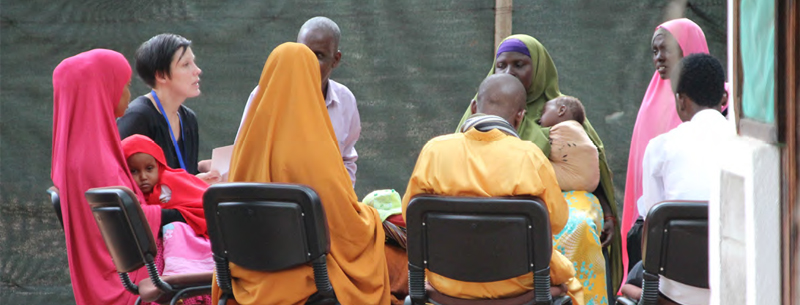This is how resettlement works
To be selected for resettlement to Sweden and be offered resettlement in Sweden, one must be registered with UNHCR, the UN’s refugee agency. UNHCR evaluates which people are in need of resettlement to a new country. They then present them to some of the countries – Sweden being one of them – that accept refugees for resettlement.

For 2024, UNHCR estimates that 110 million people will be displaced. Of these, 2.4 million were assessed to be in need of resettlement. Resettlement is used both to provide lasting protection to vulnerable individuals and to show solidarity with the host countries that have accepted many people have fled. This contributes to an increased sharing of responsibility for refugees globally and is an alternative when no other options exist. The UNHCR identifies the most urgent cases and presents their cases to the Swedish Migration Agency. Since 2023, 900 individuals per year have been resettled to Sweden.
Selection
The Swedish Migration Agency has been commissioned by the Government to carry out organised selection and transfer of refugees and persons in need of protection to Sweden through resettlement. The assignment is given annually through a government decision.
UNHCR proposes which nationalities and selection countries should be prioritised for Sweden's resettlement programme. The proposal is being analysed by the Swedish Migration Agency and anchored with the Government Offices. The decision on the allocation of places and implementation is ultimately made by the Director-General of the Swedish Migration Agency.
UNHCR presents the refugees who need to be resettled by sending personal files with documentation about each person and family to the Swedish Migration Agency.
Resettlement work at the Swedish Migration Agency is then carried out by the Swedish Migration Agency putting together teams consisting of staff with many years of experience in investigative work who travel to the places in the world where the quota refugees presented by the UNHCR are located. Usually, the team is on site for about two weeks during which they investigate, collect biometric data and make decisions on residence permits. Before a decision is made, checks are carried out by the Swedish Security Service.
A new feature from 2023 onwards is that the investigations will also include a study on the integration potential of the quota refugees. After a positive decision, the quota refugees are assigned to a municipality in Sweden.
In exceptional cases, when it involves cases that need to be transferred urgently, the Swedish Migration Agency can make a decision on the basis of the personal file sent by the UNHCR.
Only people who are refugees or persons in need of protection under the Aliens Act are granted residence permits and can thereby be resettled to Sweden. Quota refugee permits are permanent. Approximately 90 percent of those investigated within the framework of the refugee quota are granted a residence permit in Sweden.
Prognosis for good integration into Swedish society
The starting point for resettlement to Sweden shall be the quota refugee's individual need for protection. In addition, the Swedish Migration Agency must take into account the municipalities' ability to arrange a good reception and create the conditions for good integration into Swedish society and in relation to Swedish values.
The Swedish Migration Agency interprets Swedish values as the values expressed through Swedish law. For example, it can be fundamental democratic values, the rule of law, children's rights, equal rights for men and women and acceptance of minority rights. When assessing integration conditions one takes into account the person's intention to adapt to a life in Sweden, complying with Swedish law, becoming self-sufficient by participating in the integration and labour market measures offered after arrival, and learning the Swedish language by participating in the education offered through SFI.
Preparing to move to Sweden
When a refugee has received a permit to come to Sweden, the Swedish Migration Agency assigns a municipality to receive the refugee. Preparations are then made for transfer to Sweden. Resettled refugees travel directly to their municipalities and their entry is therefore dependent on whether accommodation and reception have been arranged.
The municipality that receives a resettled refugee gets information based on the UNHCR's written personal files about the refugee. It has information relevant to the resettlement, for example if the person is ill or has special needs.
Selected quota refugees receive written information about Sweden. Previously, they received information through the so-called Cultural Orientation Programme, where selected persons meet with staff from the Swedish Migration Agency and municipalities, and discuss what will happen and what quota refugees can expect. The Swedish Migration Agency is now looking into other possibilities for preparatory programmes for refugees selected for resettlement.
Transfer – the move to Sweden
When a refugee has received a residence permit and accommodation in a municipality, the Swedish Migration Agency will arrange a transfer to Sweden. People who do not have a valid passport will receive an emergency alien's passport, which will be sufficient for travel to Sweden. The so-called UT card (residence permit card) is commissioned by the embassies or by the team sent out by the Swedish Migration Agency. Sometimes, an entry visa is arranged so that a quota refugee will be able to travel to Sweden. IOM and UNHCR assist in arranging the necessary permits so that people are able to leave the countries where they are staying.
Resettled refugees may travel to Sweden on their own, in families or in groups. Sometimes, they are accompanied by staff from IOM and the Swedish Migration Agency. Upon arrival at Arlanda Airport, or the local airport, the municipality meets up with them. After this, the municipality, along with the Swedish Public Employment Service and other local parties, is responsible for supporting these individuals at the start of their time in Sweden.